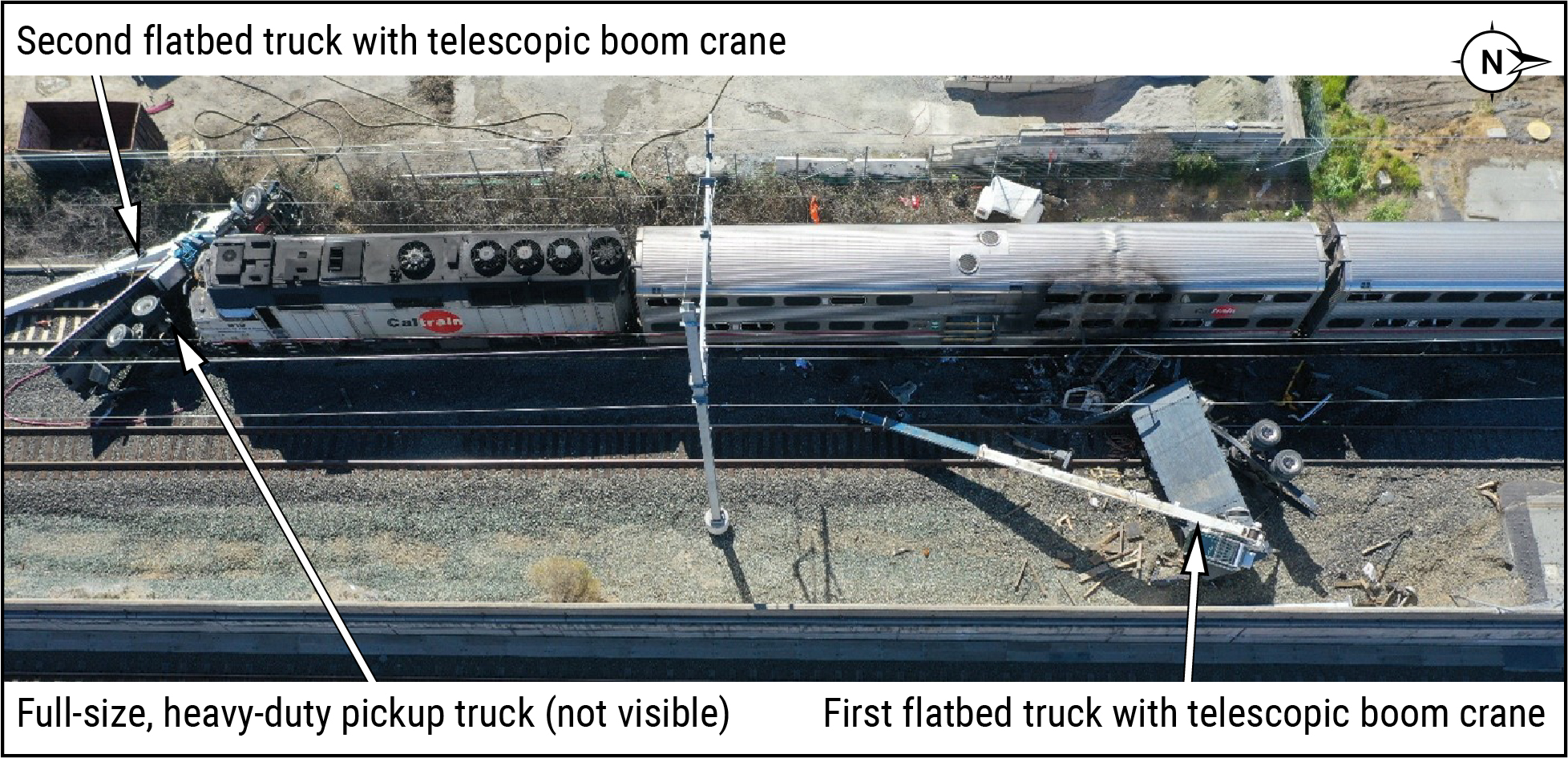This is preliminary information, subject to change, and may contain errors. Any errors in this
report will be corrected when the final report has been completed.
On March 10, 2022, about 10:33 a.m. local time, southbound Caltrain train 506 struck three stationary on-track (or hi-rail) maintenance vehicles at milepost (MP) 11.6 on main track 2 near San Bruno, California.1 The locomotive derailed, and all three maintenance vehicles were destroyed. Fuel from the hi-rail maintenance vehicles released and fueled a fire that spread to one of the passenger rail cars. (See figure.) Fourteen people reported injuries: 12 passengers, 1 train crew member, and 1 maintenance contractor. Of these, seven were transported to local hospitals, and seven were treated and released at the scene. The weather at the time of the collision was clear skies, wind from the north at 17 mph, and a temperature of 60°F. Visibility was at least 7
miles. Caltrain and its contractors estimated property damages to be almost $1.4 million.
Train 506 consisted of a single lead locomotive and five passenger railcars. The three hi-rail vehicles were two flatbed trucks with telescopic boom cranes and a full-size, heavy-duty pickup.
Before the collision, the roadway worker-in-charge received exclusive track occupancy authorization from the train dispatcher, and the maintenance vehicles entered main track 2 about 9:50 a.m.[2] They traveled to MP 11.6 and stopped to load construction materials and catenary poles staged in a fenced location next to main track 2.[3] About 9:58 a.m., the roadway worker-in-charge contacted the train dispatcher and released the exclusive track occupancy.
According to locomotive event recorder data, train 506 was travelling south on main track 2 at 63 mph toward Millbrae Station, having completed a scheduled station stop at 22nd Street Station. Main track 2 has a maximum authorized speed of 79 mph. As the train approached MP 11.6, the engineer saw the three vehicles on the track and applied the train’s emergency brake. The train slowed but did not stop before striking the vehicles. The train crew immediately began evacuating passengers through the railcars toward the rear of the train.
Following the collision, employees of the nearby San Bruno Water Corporation Yard used their work equipment to access the scene. First responders included personnel from the City of San Bruno; Central County, including Burlingame, Hillsborough, and Millbrae; San Mateo County; the City of South San Francisco; and the Menlo Park Fire Protection District. The passengers and crew were fully evacuated and fire suppression was complete by 11:14 a.m.
While on scene, National Transportation Safety Board investigators examined the accident location, equipment, signal system, and track; conducted interviews; tested the train’s brake system; and gathered employee and systems records. The National Transportation Safety Board’s investigation is ongoing. Future investigative activity will focus on railroad worker safety, training and oversight, and regulatory compliance.
Parties to the investigation include the Federal Railroad Administration; Caltrain; the California Public Utilities Commission; the Brotherhood of Locomotive Engineers and Trainmen, International Association of Sheet Metal, Air, Rail and Transportation Workers—Transportation Division; the Brotherhood of Railway Signalmen; the Brotherhood of Maintenance of Way Employes; TransitAmerica Services, Inc., and Balfour Beatty.[4]
[1] (a) All times in this preliminary report are in local time unless otherwise noted. (b) A hi-rail vehicle is a roadway maintenance machine manufactured to meet Federal Motor Vehicle Safety Standards and equipped with retractable flanged wheels for traveling on railroad tracks in addition to the highway.
[2] (a) A roadway worker-in-charge is an employee qualified to establish on-track protection for roadway work groups against being struck by trains. (b) Under exclusive track occupancy, a train dispatcher withholds authorization from trains to move through certain locations; in this case, working limits.
[3] Catenary poles support on overhead electrical system used to provide power to electrified railroad equipment.
[4] The Brotherhood of Maintenance of Way Employes Division spells the word “Employes” in its name with one final e.
